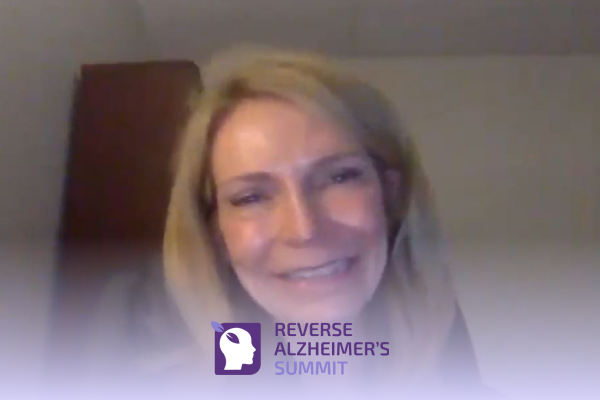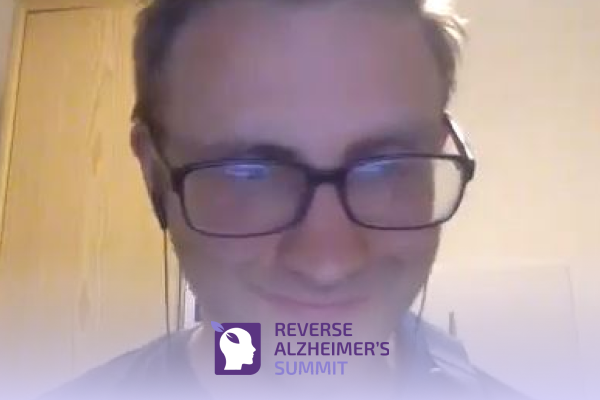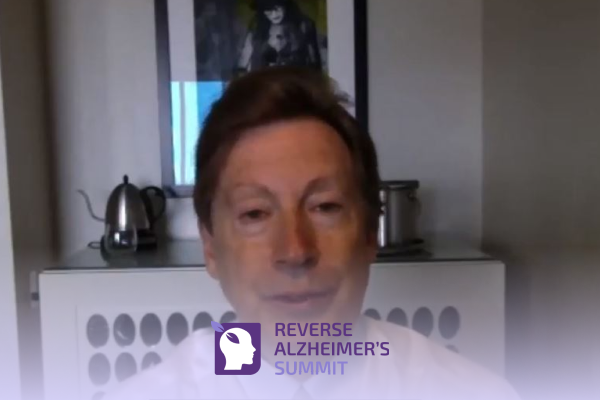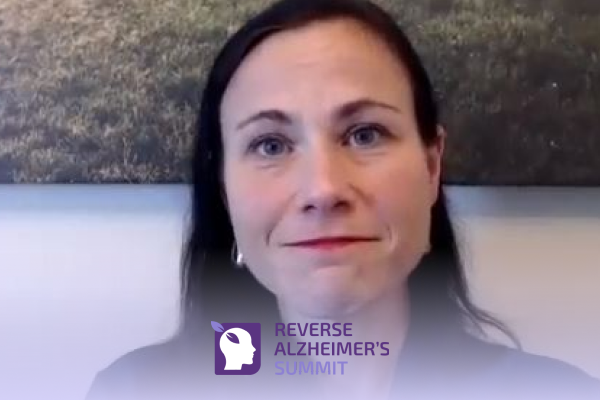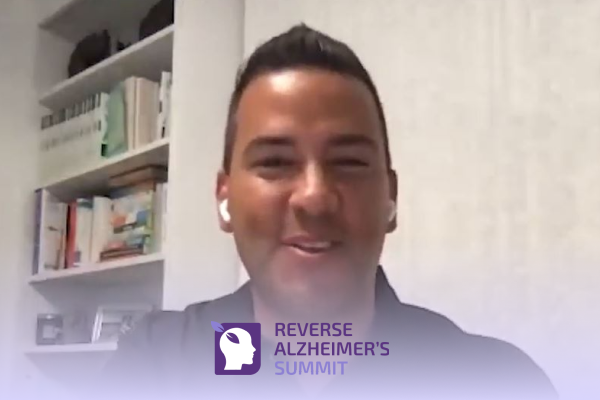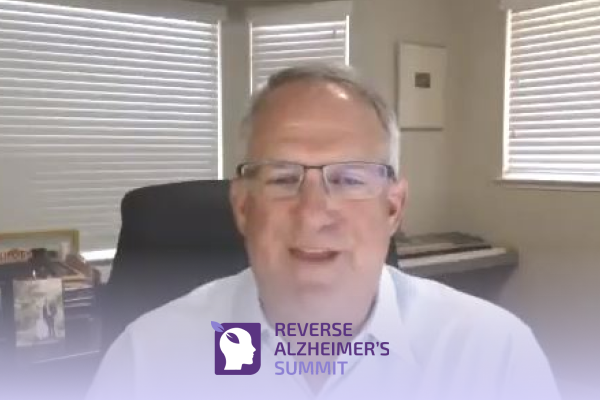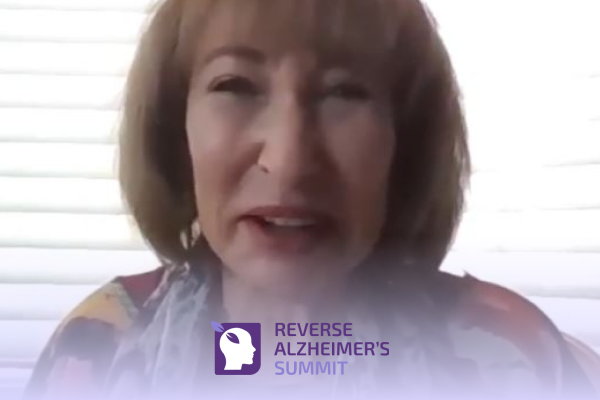Join the discussion below

Dr. Heather Sandison is the founder of Solcere Health Clinic and Marama, the first residential care facility for the elderly of its kind. At Solcere, Dr. Sandison and her team of doctors and health coaches focus primarily on supporting patients looking to optimize cognitive function, prevent mental decline, and reverse... Read More

As both an Integrative Medicine Doctor and a Pediatric Speech Language Pathologist, JoQueta takes a holistic approach to learning — considering the whole child. Dr Handy has dedicated her career to helping children with autism overcome learning challenges. She has created an educational model that improves the quality of life... Read More
Patrick K. Porter, PhD
Hello, welcome to the Reversing Alzheimer’s Summit. I’m your host, Dr. Patrick Porter. I have a very special guest, someone I’ve known for years now, and she works both ends of the spectrum from people who are autistic that have that kind of mind. But she also works with people on the end where we’re talking about here who have something with dementia or Alzheimer’s.
She has something very special that we’re going to talk about today, it’s called adaptogens. You might not have heard of them before, but it’s really hot up there in the news and in the media. People are finding that our brain is really responding to this plant-based medicine approach. And I want to just welcome Dr. JoQueta Handy to the summit. Hello, Dr. Handy, tell us a little bit about what got you into this kind of adaptogens, because when maybe explain to the audience when we talk about adaptogens and so we’re talking about, tell us a little bit about the history and why it’s important for brain health.
Dr. Joqueta Handy
For sure. Well, thank you so much, Dr. Porter. It’s wonderful to be a part of the summit and talking about the brain, recovery brain health is one of my favorite things. My story is I’ve been 30 years working with autistic children, and that was where my passion for brain health really came from. Helping them to be successful in the classroom. And I saw that both working on the gut as well as the brain, the influence between the two was very important.
And as of recently, I just recently being about the past five years, become very interested in adaptogens, and I’ve always worked with herbs. I’ve always worked with layering herbs, homeopathics. All of those are great, but the more that I’m learning about adaptogens is they can really take our brain health. They really support our brain health at a whole new level. For instance, some recent studies that have been done is looking at beta-amyloid, which is one of the, not sure if causes the right answer, but it’s one of the greatest areas that we want to focus on when dealing with dementia and Alzheimer’s.
And adaptogens are showing great promise in as not only a neuroprotective supplement, but also in, don’t wanna use the word reverse, but in lessening the symptoms of Alzheimer’s specifically around beta-amyloid. So I am super excited to be working with these new, well, I guess they’re not new. They’ve been around for a long time, but in the past five years, what I’m learning and really applying it to my practice in the past year, super excited how… Yes, it helps everyone, but we’re seeing some great research around the Alzheimer’s population.
Patrick K. Porter, PhD
Yeah, so let’s think… Let’s talk a little bit about a couple of things that were there. I want to unpack them so that everyone understands. First of all, amyloid plaques, just so everyone understands our brain has a lot of inflammation. So just like cholesterol lays down tracks in our arteries and veins, amyloid plaque lays that down in our brain because that’s where the inflammation is. And in this summit you’ve heard a lot of our doctors talk about inflammation in the brain and that’s one of our biggest problems.
So let’s go back a little bit about the antigens just for a little bit. So tell us how they’re derived. I mean, they have been around since the dawn of history. People have been using them. It’s just, they picked it out now how to isolate them, right. And use them in a very safe way. So let’s kind of go back to give them the history of this because a lot of people don’t understand plant-based medicine. They know now, almost everybody in the planet knows about CBD because it’s everywhere. You know, they’re seeing it in that it doesn’t have the same effects as marijuana or something like that, but you still get the calming effect. So they pulled that out of there. So talk from that perspective, tell us a little bit about these antigens and how they work.
Dr. Joqueta Handy
So antigens are plant-based medicine. There’s a couple of words, trendy words that are being thrown around out there, nootropics and adaptogens. So adaptogens are more in the mushroom based family medicinal, just like we talk about medicinal marijuana, we have medicinal mushrooms. So these are not in the psychedelic realm. That would be more on the nootropic side, but things like Lion’s Mane, Reishi, Chaga, Turkey Tail, Ashwagandha.
So, those are some of the ones that again, most research has been around in how it is enhancing memory, cognition, working on digestion and the immune system. What I think is so amazing about these plants is we can take one mushroom and we can have a broad spectrum of what it works on. For instance, like if we take Lion’s Mane, they did a recent study on mice and they found they specifically gave the mice a neurotoxin that produced dementia like symptoms. And when they gave the mice Lion’s Mane, the neurotoxin disappeared and therefore the dementia like symptoms disappeared. And when they continued to give the mice Lion’s Mane and reintroduce the neurotoxins, some of the mice did not develop dementia at all. And the others had very reduced symptoms.
So we see just by simply using this one plant, it is working as an amazing neuroprotect and as well as to help detox the brain. And what’s also really neat, like an herb when we stack these adaptogens, meaning when we use multiple ones at the same time, we can get a great effects across the entire body from the digestive track, the immune system, and of course in the brain. So the word nootropic is more related to cognitive enhancement. So I’m not necessarily working on my digestive track to build or change that, but I just want that immediate change in focus, attention, memory, stamina, things like that. So this one’s more on the side of long-term health, around digestion, memory and cognitive enhancement.
Patrick K. Porter, PhD
So when you… Let’s kind of unpack it for some people that don’t understand a little bit about what you’re saying. ‘Cause there was a few things that caught me. I mean, when we talk about the gut, a lot of people don’t understand the connection between the gut and the brain. I know we have a lot of our doctors who are gonna be talking about them. They might’ve missed those and what was going on. So tell us a little bit about why is it important that we balance this information between the brain and the gut or what’s that connection.
Dr. Joqueta Handy
For sure. That’s what autistic children have taught me the most about. Autism is a hundred percent gut. And because 95% of serotonin is made in the gut, serotonin that helps put our brain to sleep, keep our brain asleep at night. We call it our happy hormone, provide that homeostatic state on a daily basis that calm homeostatic state. So if there are issues in the intestine, creating malabsorption, creating inflammation that is going to directly affect the brain. We also in the brain produce neurotransmitters and those neuro-transmitters are hormones, which convert into polypeptides to help us digest our food. Neuropeptides, the hormones that work on our autonomic nervous system.
So again, the gut and the brain are indirect communication all the time. And one influences the other. Many times when I’m working with patients, it’s always trying to figure out which one came first. Was there a breakdown in the gut that influenced brain health or was it a breakdown in brain chemistry that influenced gut health, but you will always see the two going together.
And it’s important to work on both of them at the same time. And that was what I learned early on in autism when we were just trying to get vitamin absorption up and trying to improve their eating habits and reduce gut inflammation. We had to focus on the two at the same time because you saw many of the aggressive behaviors and sleep issues and many of the lack of attention and focus that autistic children have. So that’s, again, what I think is so amazing about adaptogens, because we can give one adaptogens Lion’s Mane and have across the board brain, gut and immune system all just within one adaptogens.
Patrick K. Porter, PhD
That’s great. So I’ve been reading recently about the gut biome in the brain biome that nobody really was talking about that before. So tell us a little bit about, I know they mirror too. Some people are showing that if they have, let’s say gut biosis, they probably have that same thing happening in the brain. So, tell us a little bit about how that mirrors and you talked a little bit about serotonin, but really what percentage of the neuro-transmitters are made in the gut, what percentage is made in the brain? ‘Cause that’s really important for people to understand.
Dr. Joqueta Handy
So yes, the gut biome, we, again, I feel that autistic children really led the pack in us studying this and understanding it at a higher level. And you know, right now there’s so much information about, doing intermittent fasting to improve the health of your gut so that the liver, because the liver will only detox when it’s in its four stage of digestion. So, which is the final phase. And most of us don’t get to that final phase because we’re putting something else into our mouth. And that final phase occurs for most people between 10 to 12 hours of the last thing that goes into our mouth. And so using intermittent fasting, we’re just making sure that we get to that detox level or even surpass it a little bit more when people are doing like 16 hours of intermittent fasting that can even be even better in terms of our health.
So there’s ways that we can force the gut to detox every day we’re taking on toxins, we’ve learned from autistic children that we can even have toxins transferred from conception, in the womb. And so it’s much harder to force the brain biome to detox. And we have those particles floating around every day that we’re taking in from environmental toxins, the breakdown of glycogen, all of the different neuro pieces that go in on a daily basis that keep us functioning, alert, responsive, and processing, and the greatest detox of the brain occurs at night.
And it occurs when we’re in REM sleep. And I’ve heard you talk about the importance of REM sleep of all of our sleep cycles since I very first met you. And that REM sleep appears to be the greatest within the detox of the brain microbiome. Our brain even though it’s detoxing 24/7, the greatest detox occur 60% increase occurs during REM sleep and GABA is very dependent for a REM sleep. So one of the things that in my formulation both Adapt and Thrive. I used ashwagandha, ashwagandha is a GABA agonist. So by taking those in the day, we’re increasing our GABA levels for sure, by taking a Adapt at bed, we’re increasing our GABA levels and we’re increasing that probability of REM sleep. Also in Thrive I used Niacin, Niacin is kind of a little insurance policy that we’re getting that delivery system.
Niacin also helps with GABA and GABAA ensures that we’re crossing the blood-brain barrier. So again, as I mentioned, this stacking of the different adaptogens with B3, Niacin, sometimes people use black pepper as another way of getting it into the crossing, the blood-brain barrier, the uptake mechanism, but very important for us specifically, if we’re talking about GABA. What happens with REM sleep is just because of our lifestyle because of issues in the gut related to serotonin as I alluded to at the beginning, serotonin is something that helps to influence the theta wave of the brain. Very important as the sun is setting to help make us drowsy, to begin to prepare the brain to go to sleep.
And then that final piece of putting our brain to sleep serotonin rising and staying at the right level throughout the night to keep us asleep. So if there’s gut issues, many times that serotonin cycling is not happening or it’s not happening at an appropriate level. And so many of us are staying in a theta state versus going into that REM sleep our dreaming state when so that the brain can detox. Another issue is they found people doing shift work greatly can influence REM sleep.
So when I worked with the brain treatment center back in 2009, and the studies that we did there, we found that it was necessary really two hours of REM sleep is the absolute best. If we can at least get to over an hour, that is a healthy state. Most of us stay around 20 or 30 minutes of REM sleep. So that brain, those little particles that we were trying to clear out of the brain, it doesn’t ever happen. And so then the buildup of toxicity occurs and the amyloid plaque is one of the greatest ones. So I think it would be really interesting to see if we were just all getting better sleep the necessary sleep. Would we see the decline in epidemic stages of Alzheimer’s and dementia? I think it’s a very important first step and something that is very easy to do, doesn’t require a lot of effort if we’re focusing on that area in brain chemistry and really supporting that area of brain chemistry. I think that is the very first necessary step in moving toward a higher level of health.
Patrick K. Porter, PhD
Yeah. And I agree. I mean, they say that two thirds of the population is not sleeping through the night and that includes the population it’s probably higher than that in the Alzheimer and the dementia, because they don’t… The brain is not cycling like you said. And what we found in our studies is that if they don’t have enough theta which produces that GABA, they’re not going to sleep through the night.
So, when you’re talking about that. So you’ve been involved in a lot of research, a lot of things. So how would you correlate? I know that Dr. Kelly Miller, who’s also on the summit, he’s talking about the dementia brain and the ADHD and ADB brain, and they’re pretty similar. I mean, if you put them up on a screen, you would think, oh, they’re the same brain, but they’re similar. So because the brain is dysregulating, it’s not imbalanced. It has all these different features. What have you found is the connection when you look at these two types of brains, when you look at, from the youngsters that their brain is dysregulated to the adults where their brain starts to disregulate, and maybe it’s the amyloid plaque, like you’re saying, they don’t really know, but I know MIT spent millions of dollars out of it.
We got to meet Lou Thai. And she was talking about how they’re using the light to break it down. So this is another piece, we believe that in therapy, there has to be this kind of stacking of different applications to get the results. So tell us in your research, first of all, what have you seen in these two? Just kind of in general, when you’re looking at these two brain types or how similar they are and how different they are?
Dr. Joqueta Handy
Well, I think the keyword that you use is dysregulation. So both of them are showing dysregulation. We’ve learned from autism and studying the brain. You can have 10 autistic children in the room and you can have 10 different children. And I think that’s what in that specific disease, what is made it show difficult to treat? And I think, even though we know so much more about the brain than we did 10 years ago, 50 years ago, we’re constantly learning and that’s the key, we’re constantly learning more and more about this intricate computer. And in my opinion, one of the greatest things that is influencing our finding connections or finding the key connection is toxicity.
So you’re with glyphosate is one of my favorite things to talk about because we are saturated in glyphosate. And for anybody who doesn’t know what that is, that’s Roundup Ready, the weed killer times 10, I’m so much more powerful than just using Roundup Ready. And our seeds, our ground, our water has been saturated in it since the early nineties. And it hasn’t even been a steady saturation. It has increased each year. We are using more and more and more glyphosate. They are finding that it’s one of the main reasons when we talk about the gut that we are seeing children born without good gut bacteria, which is so important for the health of the colon, for the health of that gut microbiome. And so, again, as we were talking, that’s going to immediately directly influence the brain because of that chemical connection.
We know that glyphosate as Robert F. Kennedy Jr. won the lawsuit two years ago in August last year, I can extract the time and in August proving that glyphosate can cause lymphoma in the groundskeeper. Now that is just created this overwhelming class action lawsuits. With the last time I heard there were 4,000 lawsuits with cancer and involving the direct exposure to glyphosate. So glyphosate also is affecting our sulfate levels. Dr. Stephanie Seneff, one of my favorite researchers at MIT has found that because of the use of glyphosate, we are at a epidemic sulfate deficiency, and sulfate is very important like you probably have heard of chondroitin sulfate, okay. That’s sulfate piece is very important in our gut health as a neuroprotective and directly influencing the brain. So I think there are so many variables when we talk about dysregulation in the brain. It’s almost like a needle in a haystack.
It should not be that way, but because of the use of toxins specifically glyphosate, but there’s many, many others we’re using high portions of heavy metals in our environment, in our vaccines or medicine or cosmetics, all of those things. So because of all of these chemicals that are within our environment and how they’re affecting us, glyphosate leading the pack, I think that dysregulation, that it is causing between the gut and the brain makes it to have a lot of variables that we have to consider in doing measurements.
So in looking at the brain between an ADD ADHD child, we know that toxicity is one of the greatest things that causes dysregulation in that area. We haven’t been able as much as autism to isolate, ADD ADHD just to the gut. So we’re focusing on the gut first, but as I said, we have to work on both of them together, but we do know for sure that the toxicity that is present within the brain, that Dr. Eamonn identified the ring of fire many years ago in his research, that ring of fire is caused from a lack of blood flow, a lack of circulation in the frontal lobe of the brain that has most been linked to toxicity. And when we talk about toxicity, we’re talking about bacteria, virus, heavy metals can even be parasites or toxics now not that they were reclaimed, but parasites actually carried Lyme’s disease.
That was proven by Dr. McDonald in 2016. And the number one thing that that toxicity is causing is brain tumors. So I think there are so many variables when we look at the two in trying to isolate what created this dysregulation. And again, not to sound like a broken record, but that’s why I think that adaptogens can be such a huge piece in helping us in that broad spectrum healing in being able to have the neuro protect the immune and the gut all at the same time.
Patrick K. Porter, PhD
I know as an integrative medicine practitioner, you get a lot of things come your way. You have to experiment with them, see if they work for you. But I know you have some personal stories about this, with your family. I mean, your own son started using them as kind of a proof point for you. So maybe you can tell us a little bit about what you’ve seen happens once somebody starts taking these adaptogens.
Dr. Joqueta Handy
For sure. So I very much interested in the psilocybin research. Johns Hopkins has been doing that for 20 years now. And I think that’s, what’s so neat again about adaptogens, whether we’re using it on the neurotropic, the psychedelic side, or we’re just staying on the plant medicine side, we’re able to research that for so long. We weren’t even able to research CBD here. We were having to get that research from Israel, but our research is way ahead of our legislation right now. And so Johns Hopkins has looked at the use of what’s called micro-dosing. So same thing as what we talk about with CBD of using low levels of CBD and even THC to create healing effect.
So not going to a level that is causing hallucinations, but that low level, the same thing can be used with psilocybin, which is also known as magic mushrooms. And that’s what Johns Hopkins looked at. So they found that when we used low levels of psilocybin, it created amazing effects within the brain. Alzheimer’s has been one of the leading studies it’s been done. It’s just reading a study yesterday in talking about combining Lion’s Mane that we talked about that has a great effect on focus, attention, and digestion. And when they combined that with psilocybin they actually showed effects of early onset dementia, and Alzheimer’s completely disappear.
They’re not ready to come out with that research and say that it is something that can reverse Alzheimer’s and use that word, but certainly it is being presented as a neuroprotective device. So when I read this research and having my background in autism and working on brain chemistry, I just became almost obsessed with it. And so my son has… We have four boys and one girl and our daughter just got married on Saturday. And our fourth son, third son had a disorder when he was born called craniosynostosis, which just means that three out of the four cranials were closed. And so that’s ’cause the brain has the greatest growth during the first three months of life. And so that caused his head to look like a football within about three weeks of birth. And so they went in and opened the skull so that the brain had room to grow when he was five weeks of age.
But out of the four boys out of the five children, Zachary always suffered with anger management, kind of had the shortest views as he got older, he’s moved into teenage years around 15. He started having issues with depression and it actually started the sleep issues. And when I first got, he was 16, when I first got a BrainTap, he’s 24 now. And I was reading about it and I’m like, “Zach, this says that it will help you with sleep.” And he was like, you know, I’m always trying to get them to take something to something. And he was like, “Okay, whatever mom.” And came back to me the next night. And he was like, “This worked.” And after five nights, he was sleeping through the night, even without using BrainTap. And it is still to this day at 24, his go-to device, all of our children went to college with it.
They used it in high school and college sports. Zach has been the one that has continued, on a weekly basis to use BrainTap, but he was still experiencing when he got to college, suicidal thoughts started developing, especially around age 19. And he continued to battle and have to work very hard on it, literally on a daily basis, just to kind of quiet the voices, as he would say, the negative thoughts and the anxiety that occurred from just opening his eyes in the morning. And so in working with adaptogens, I said, “Zach, I wanna try something.” Let’s try some micro dosing as psilocybin with stacking, with using things like Lion’s Mane, ashwagandha, Bacopa. So, some very specific adaptogens, Niacin, and just happens to be what’s in the formulation of Adapt and Thrive that I’ve done. And I said, “Let’s combine this with a microdose”, meaning, less than 200 milligrams of psilocybin. And we did a 21-day trial.
So he would take psilocybin with the adaptogens on day one. He would take only the adaptogens, no psilocybin on day two and three. On day four, we would reintroduce the psilocybin. And we continued in that way. So he only had out of 21 days, he had a total of seven doses of psilocybin, but 21 days of adaptogen use. And with that, we always talk about the pill with the skill. And so with that, we used breath work, which is a very important way to control and modulating the nervous system. And they’ve been using it for years called Lamaze in birth in women giving birth and Navy Seals use it. So using breath work, I gave Zach several examples.
I said, you go find the one that works the best for you because breath works kind of like exercise. If you don’t like it, you’re not going to keep doing it. And there’s lots of techniques out there to try. So Zach began exploring and experimenting. He resonated the most with Dr. Joe Dispenza and his meditation breath work series. So he was doing that every single day for the 21 days. I also told him you have to be in an exercise program. So whatever that is that you like, Zach’s always enjoyed running. And so he got back into running on a daily basis, and I said, we’re going to clean up your food, processed food, food with, you know, high processed food has a high sugar content that is a neurotoxin for your brain, as well as for your gut.
So we worked on his diet to bring it back to your plant-based diet with chicken and fish and eliminating white sugar altogether. And then the last thing that we did was also to bring in some extra meditation. So Dr. Joe Dispenza uses a very unique kind of breathwork and meditation together, but Zach was also doing just some meditation at night, right before bed, because for him mornings are always the toughest time. And I think digestion plays a big role in that. So that was the course of action that we did. We did not do any other herbs supplementation or anything like that. He was using BrainTap, just like he always had. He did not stop using those practices. His favorite one is Mountaintop-
Patrick K. Porter, PhD
BrainTap Retreat app.
Dr. Joqueta Handy
That’s it.
Patrick K. Porter, PhD
He was just recovering from
Dr. Joqueta Handy
Okay, that’s his favorite one. So he was using that on a daily basis as well. So many bringing frequencies together to create the highest level of change. And Zach has always been one… Our children have always gotten along very well we’re a blended family of 15 years and Jim and I always say our children fell in love first. And then we fell in love. So they’ve always been a great group, but if there was ever a conflict Zach was in the middle of it. And my husband and Zach could, you know, they could trigger each other just about faster than anything. And I didn’t tell him, I didn’t share with Jim that Zach and I were trying this little experiment. And he works here at the office and he came into the office within the first week.
So we were only on day three. He had only had one dose of psilocybin and the three doses of the adaptogens support. And my husband said, “What’s up with him?” And I’m like, “What do you mean?” And he was like, he just has a different energy. He has a different awareness. Zach has never had a lot of empathy, and he’s always kind of been more self-absorbed, self-centered and he was like, “What’s going on with him?” I’ve never seen him like this. And even the way he spoke and he approached, it was in a much calmer way. So I started sharing with Jim what we were doing. I kind of get a raised eyebrow.
And he was like, “Well, we’ll see how that goes.” And at the end of 21 days, Zach could meet some big life changes and was seeing things, just able to see daily life in a different way. And he has continued to do BrainTap. I don’t think he’s been as diligent with his breath work and meditation as maybe he should. He has not made that a daily practice, but he has continued to use BrainTap at least three times a week, and sometimes more and diets been a little iffy, but continue to use the adaptogens on a daily basis and has not had any anxiety, has continued to be empathetic, has continued to be able to be focused. ADD was very much, he never had a form of diagnosis, but was very much a part of, even though he got through school, he always made good grades. Again, he had to really work hard to remain focused and get assignments done on time. So he was much more diligent in just reaching out, what do you need? How can I help? And that had never been part of his personality before.
So in personally watching it and how rapid the change was. It was like, okay, everybody can benefit from this. So, just the average daily person. And I think right now, when we look at the use of psychotropic drugs, the us uses more than the entire world combined. And I saw early on within my practice back in the mid nineties, we had 200 children on psychotropic drugs, and it was through the Amen Clinics. And we had only 3% that showed a positive effect. And now we’re learning. We knew that we could tell from brain scans that this permanently changed the brain. We just didn’t know at that time, was it a positive change or a negative change. And now, you know, 15, 20 years later, we’re realizing it is not a positive change.
Many of the children that were put on ADD ADHD meds, some as young as four years of age struggled very much with drug dependency, self-medication, alcohol. I just met a wonderful 22-year-old young man in my office last week, who was one of those children and he is clean and sober now, but he was talking to me about, on a daily basis, the drive that he has to work on and control. And so we’re going to use the same therapy that I used with my own son with him. So I’m really excited to see where that might go. But I mean, just to think that our innocent children, that we started on these medications, you know, not pointing a finger at the parents, you were told that it was going to help.
You were given misinformation. And now the struggle that your 20 plus year olds are facing. So if we can come up with something that will help them, I think that’s amazing and looking at our elderly and our aging, our medicine is incredible at saving lives. but it’s not great at the quality of life that it provides. So when we look at our aging population, they’re on, at least for the average 60-year-old is on four medications. And I was just reading a book on the plane going to New York this weekend or this past week. And it was called “Being Immortal”. And it was talking about those specific four drugs and the way that they just slowly deteriorate the quality of our health and especially in women and seeing the rise in dementia, seeing the rise in balance issues, broken hips, and it can so easily be prevented just in taking some different courses of action on cholesterol and blood pressure and sugar regulation and improving that quality of health.
And this book went all the way through following people into assisted living and how that has increased since the 1950s. So we’re not changing, we’re not learning from in medicine. And this was an MD who wrote this book and we’re not learning from experience and saying, okay, let me see if I can do it differently. So as I get older, I am especially, I don’t want to end up like that and protecting my brain with, again, just the level of chemicals that we’re faced with on a daily basis. If I have a solution that can help me in that way, for sure, I’m a hundred percent for it. And if there’s ways that I can share this information with other people, whether it’s from our children with ADD ADHD, autism, or our aging adults, our aging parents, or just like me, an individual at 53 years old, I don’t want to age before any faster than what I should. So that’s kind of the message that I want to get out and just the role that adaptogens can play.
Patrick K. Porter, PhD
Great, when somebody is thinking about, as we wrap this up here, a couple of questions come to mind. One is because you’re into natural medicine as well. And you mentioned a few times about sugar, and we do have Dr. Daryl Gioffre who wrote the book, “Get Off Your Sugar”. So we’re going to be talking about that and how that’s one of the most lethal toxins out there. But as far as what people can do, you’ve given us some tips already reduce your sugar, besides the adaptogens, in your case, what do you do with them? And then maybe you can tell us what we can do if they can’t get it in their diet, which is going to be almost personally possible in this case, but what can they do to assist the brain that you found is maybe some major things they can do. And then how did they find out about adaptogens and how do they, what can they do? What’s their next step in their education?
Dr. Joqueta Handy
Okay. For sure. So, well answering the questions, how can you find out about adaptogens? You can go to our website, which is mybrilliantblends.com and learn, we have a lot of information, reading resources, a blog site, and we’ve linked to several other websites that have a lot of information on them as well. Dr. Mercola just put out a newsletter a couple of weeks ago on the top five adaptogens that everyone should be taking.
They happened to be what’s in Adapt and Thrive. So she can also just use those. And so there is a lot of resources out there and through the website, we’re trying to connect people to those websites. The other part is just in, what can you do? I think that skill piece, the pill with the skill, yes, adaptogens they’re… One of the things I didn’t mention is they are a hundred percent natural. So what does that mean? Well, you can go to the ground, you can pick the adaptogens, you can pick the mushroom, you can dry it, you can grind it, you can put it in a pill and take it. So talk about organic most natural form.
That’s what they are. And I think that’s why they’re so powerful. How is that different than a vitamin? So if you go into the drug store or Costco and you pick up a bottle of vitamin C, vitamin C is, you’re like, well, that’s natural, right? That occurs in oranges and citrus fruit. Well, if you look at a bottle of vitamin C, it has a lot of synthetics in it. The average vitamin C bottle, a capsule has more synthetics than it does the actual vitamin C. And what we learned from autism is that many people react to what’s in the food than the food itself. So the preservatives and the additives, and just like I was talking about with, using Niacin, which helps with as a carrier, which helps stimulate GABA so that it crosses the blood brain barrier. That when you add in all these synthetics, it’s not going to get to the blood-brain, cross the blood-brain barrier. And there’s a big chance that it’s not going to permeate into the gut as well.
And so, you know, a lot of doctors like to say, well, vitamins are just a bunch of bunk and you’re just gonna pee them out. Well, when they’re set up that way. Yes they are. And so the biggest thing about the adaptogens being a hundred percent natural is a huge piece. Other things that we can do to support the brain; nutrition, even though we have messed up our food in a major way, nutrition is important. It used to be our best medicine. It’s not anymore, but it is at least 50% of the mix. So in not eating processed foods, that’s high in saturated fat, high in sugars. One of the questions I asked my patients, my new patients, when they come in is, “How many white sugar products do you eat today?” Most of them say zero, and I’m like, “Hmm, but you live in the US?” 99% of the American diet is sugar. And there are so many hidden sugars that were fooled about, patients don’t realize when they’re eating a chip or a cracker that they are getting sugar. So I’m looking at your diet. I’m very much of an advocate of a plant-based diet using chicken and fish, lean turkeys. And of course, grass fed-grass, grass-finished beef, but limiting the red meat as on a regular basis. But certainly I’m not saying to cut that out of your diet.
I know some people to say completely eliminate that, looking at our grains because our grains are saturated in glyphosate. They’re one of the wheat is one of the leading GMOs, soy one of the leading GMOs. And soy bean oil is our cheapest oil and is used in all processed foods. It’s used in a lot of restaurants, it’s used in all fast food restaurants, so contributing to amyloid plaque for sure, it is a big leader. So it’s important to read labels. It’s important to receive education on nutrition and be able to apply that and making good choices. BrainTap, always huge advocate.
I think that’s an amazing tool in supporting brain health. And what I love about it is it can be used for everybody. I mean, I’ve used it with autistic children for years. We used it in our schools as part of our daily curriculum. We used it in many ways from just helping with focus and attention all the way up to stimulating speech and language. Just like I mentioned with my son, he used it as a way of helping to reduce anxiety. I know when we did the research study with the moms group; ASD moms group, they found that it was what helped wake them up and get them going in the morning.
So for sure, I think BrainTaps should be a major part of our daily regimen in helping to support our brain. Breath work, because where does a lot of the dysregulation come from in both the gut and the brain, it comes from the autonomic nervous system that vagus nerve not being in a parasympathetic state, but staying in a sympathetic state, which is fight or flight. And so through the use of BrainTap and breathwork, we can help reset that mechanism. Sometimes we need to do it on a daily basis. Sometimes it may be that 20 day concentrated course of reset. And then we can back off a little bit, but you always have your breath with you. And so it’s always a tool that you can go to and use.
So I really challenge everyone to find that breathwork like that exercise regimen that you like and enjoy. There’s some wonderful YouTube videos. And as I mentioned, Dr. Joe Dispenza has a whole library that you can choose from in that area. You can join monthly calls that he does and talking about it. So there’s a lot of support there. I think those… I don’t know if I left anything off and sleep, we gotta get you sleeping.
Patrick K. Porter, PhD
We’ve talked a lot about sleep during the summit. So you’ve got a little bit, but as we wrap it up, I want everyone to know they can follow you on social media. They can learn more about you through Facebook or Twitter or Instagram. So why don’t you share a little bit of that with the listeners, how they find out about you?
Dr. Joqueta Handy
For sure. Well, it’s brilliantblends. That’s the name of our company. That’s the name of our supplement. That URL just wasn’t available. So we had to use my brilliant blends, but everything else, Instagram, Facebook, and Twitter, we are on a brilliant blends. So @brilliantblends. So we would love to have you join us and be a part of, again, blogs and questions, and just daily postings that we do all around the brain.
Patrick K. Porter, PhD
Right, I’m going to encourage everyone to follow Dr. JoQueta, she’s on the cutting edge. He’s always been there with research. If I want to know what’s going on, especially with the gut brain connection, JoQueta is one of the first people we call, we connect with, we watch what she’s doing. We’re also going to be involved in some research together. So if you’d like to you’re here, we’re going to be following up. We’re going to do some massive research. We have some universities that are now wanting to engage in and get this in, because I think, we have the full spectrum of people.
Like you said, everybody needs this. We just have to, a lot of people need more research, but we’re going to encourage you to start doing some research, start learning, start taking back your health. I love the statement that the skill with the pill. A lot of people are looking for the pill. You know, we have a saying here, you either have a pill, you take a pill or you take responsibility. So this is kind of marrying the two because we don’t get it from our foods, we don’t get it from our lifestyles anymore. So Dr. JoQueta, thank you. And is there anything you want to leave the summit attendees with before we say goodbye and move on to the next speaker.
Dr. Joqueta Handy
Go get your adaptogens, mybrilliantblends.com is a great place. We have discounts, we have free shipping and we have a lot of information. Of course, if you have any questions, you can also reach out to me personally and I would be more than happy to help in answering any of those questions and help you on your journey of how to dose them, which ones are the right ones to use.
Patrick K. Porter, PhD
Thank you again. And you might not have known about adaptogens before the call. Now you have at least a baseline information. Let’s go do our research. Find out if it’s something for you. I believe it is. I take these products. That’s why she’s on the summit here with us, and I’ve seen it work for other people in the world. So let’s get out there, improve our brains, improve our lives and start living our best lives today. So again, thank you, Dr. JoQueta.
Dr. Joqueta Handy
Thank you, Dr. Porter. My pleasure!
Downloads

